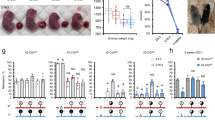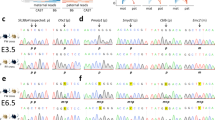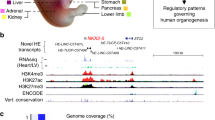Abstract
Genomic imprinting is an epigenetic process that restricts gene expression to either the maternally or paternally inherited allele1,2. Many theories have been proposed to explain its evolutionary origin3,4, but understanding has been limited by a paucity of data mapping the breadth and dynamics of imprinting within any organism. We generated an atlas of imprinting spanning 33 mouse and 45 human developmental stages and tissues. Nearly all imprinted genes were imprinted in early development and either retained their parent-of-origin expression in adults or lost it completely. Consistent with an evolutionary signature of parental conflict, imprinted genes were enriched for coexpressed pairs of maternally and paternally expressed genes, showed accelerated expression divergence between human and mouse, and were more highly expressed than their non-imprinted orthologs in other species. Our approach demonstrates a general framework for the discovery of imprinting in any species and sheds light on the causes and consequences of genomic imprinting in mammals.
This is a preview of subscription content, access via your institution
Access options
Subscribe to this journal
Receive 12 print issues and online access
$209.00 per year
only $17.42 per issue
Buy this article
- Purchase on Springer Link
- Instant access to full article PDF
Prices may be subject to local taxes which are calculated during checkout



Similar content being viewed by others
References
Barlow, D.P. Gametic imprinting in mammals. Science 270, 1610–1613 (1995).
Barlow, D.P. & Bartolomei, M.S. Genomic imprinting in mammals. Cold Spring Harb. Perspect. Biol. 6, a018382 (2014).
Moore, T. & Haig, D. Genomic imprinting in mammalian development: a parental tug-of-war. Trends Genet. 7, 45–49 (1991).
Spencer, H.G. & Clark, A.G. Non-conflict theories for the evolution of genomic imprinting. Heredity (Edinb.) 113, 112–118 (2014).
Wilkins, J.F. & Haig, D. What good is genomic imprinting: the function of parent-specific gene expression. Nat. Rev. Genet. 4, 359–368 (2003).
Curley, J.P., Barton, S., Surani, A. & Keverne, E.B. Coadaptation in mother and infant regulated by a paternally expressed imprinted gene. Proc. Biol. Sci. 271, 1303–1309 (2004).
Wolf, J.B. & Hager, R. A maternal-offspring coadaptation theory for the evolution of genomic imprinting. PLoS Biol. 4, e380 (2006).
Babak, T. Identification of imprinted loci by transcriptome sequencing. Methods Mol. Biol. 925, 79–88 (2012).
Babak, T. et al. Global survey of genomic imprinting by transcriptome sequencing. Curr. Biol. 18, 1735–1741 (2008).
Wang, X. et al. Transcriptome-wide identification of novel imprinted genes in neonatal mouse brain. PLoS ONE 3, e3839 (2008).
DeVeale, B., van der Kooy, D. & Babak, T. Critical evaluation of imprinted gene expression by RNA-Seq: a new perspective. PLoS Genet. 8, e1002600 (2012).
Gregg, C. et al. High-resolution analysis of parent-of-origin allelic expression in the mouse brain. Science 329, 643–648 (2010).
Tran, D.A., Bai, A.Y., Singh, P., Wu, X. & Szabo, P.E. Characterization of the imprinting signature of mouse embryo fibroblasts by RNA deep sequencing. Nucleic Acids Res. 42, 1772–1783 (2014).
Calabrese, J.M. et al. Site-specific silencing of regulatory elements as a mechanism of X inactivation. Cell 151, 951–963 (2012).
Wang, X., Soloway, P.D. & Clark, A.G. A survey for novel imprinted genes in the mouse placenta by mRNA-seq. Genetics 189, 109–122 (2011).
Schulz, R. et al. WAMIDEX: a web atlas of murine genomic imprinting and differential expression. Epigenetics 3, 89–96 (2008).
Kim, J., Bergmann, A., Wehri, E., Lu, X. & Stubbs, L. Imprinting and evolution of two Kruppel-type zinc-finger genes, ZIM3 and ZNF264, located in the PEG3/USP29 imprinted domain. Genomics 77, 91–98 (2001).
Morison, I.M., Ramsay, J.P. & Spencer, H.G. A census of mammalian imprinting. Trends Genet. 21, 457–465 (2005).
Morison, I.M., Paton, C.J. & Cleverley, S.D. The imprinted gene and parent-of-origin effect database. Nucleic Acids Res. 29, 275–276 (2001).
Schaller, F. et al. A single postnatal injection of oxytocin rescues the lethal feeding behaviour in mouse newborns deficient for the imprinted Magel2 gene. Hum. Mol. Genet. 19, 4895–4905 (2010).
GTEx Consortium. The Genotype-Tissue Expression (GTEx) project. Nat. Genet. 45, 580–585 (2013).
Fang, F. et al. Genomic landscape of human allele-specific DNA methylation. Proc. Natl. Acad. Sci. USA 109, 7332–7337 (2012).
Li, X. et al. Transcriptome sequencing of a large human family identifies the impact of rare noncoding variants. Am. J. Hum. Genet. 95, 245–256 (2014).
Court, F. et al. Genome-wide parent-of-origin DNA methylation analysis reveals the intricacies of the human imprintome and suggests a germline methylation independent establishment of imprinting. Genome Res. 24, 554–569 (2014).
Wilkins, J.F. & Haig, D. Parental modifiers, antisense transcripts and loss of imprinting. Proc. Biol. Sci. 269, 1841–1846 (2002).
Wilkins, J.F. & Haig, D. Genomic imprinting of two antagonistic loci. Proc. Biol. Sci. 268, 1861–1867 (2001).
Bischof, J.M., Stewart, C.L. & Wevrick, R. Inactivation of the mouse Magel2 gene results in growth abnormalities similar to Prader-Willi syndrome. Hum. Mol. Genet. 16, 2713–2719 (2007).
Potes, C.S. & Lutz, T.A. Brainstem mechanisms of amylin-induced anorexia. Physiol. Behav. 100, 511–518 (2010).
Wutz, A. et al. Non-imprinted Igf2r expression decreases growth and rescues the Tme mutation in mice. Development 128, 1881–1887 (2001).
Tzouanacou, E., Tweedie, S. & Wilson, V. Identification of Jade1, a gene encoding a PHD zinc finger protein, in a gene trap mutagenesis screen for genes involved in anteroposterior axis development. Mol. Cell. Biol. 23, 8553–8562 (2003).
Pereira, V., Waxman, D. & Eyre-Walker, A. A problem with the correlation coefficient as a measure of gene expression divergence. Genetics 183, 1597–1600 (2009).
Renfree, M.B., Hore, T.A., Shaw, G., Graves, J.A. & Pask, A.J. Evolution of genomic imprinting: insights from marsupials and monotremes. Annu. Rev. Genomics Hum. Genet. 10, 241–262 (2009).
Xie, W. et al. Base-resolution analyses of sequence and parent-of-origin dependent DNA methylation in the mouse genome. Cell 148, 816–831 (2012).
Parkhomchuk, D. et al. Transcriptome analysis by strand-specific sequencing of complementary DNA. Nucleic Acids Res. 37, e123 (2009).
Frazer, K.A. et al. A sequence-based variation map of 8.27 million SNPs in inbred mouse strains. Nature 448, 1050–1053 (2007).
Keane, T.M. et al. Mouse genomic variation and its effect on phenotypes and gene regulation. Nature 477, 289–294 (2011).
Grubb, S.C., Bult, C.J. & Bogue, M.A. Mouse phenome database. Nucleic Acids Res. 42, D825–D834 (2014).
Ashburner, M. et al. Gene ontology: tool for the unification of biology. The Gene Ontology Consortium. Nat. Genet. 25, 25–29 (2000).
Croft, D. et al. The Reactome pathway knowledgebase. Nucleic Acids Res. 42, D472–D477 (2014).
Guberman, J.M. et al. BioMart Central Portal: an open database network for the biological community. Database (Oxford) 2011, bar041 (2011).
Delaneau, O., Zagury, J.F. & Marchini, J. Improved whole-chromosome phasing for disease and population genetic studies. Nat. Methods 10, 5–6 (2013).
Zhang, R. et al. Quantifying RNA allelic ratios by microfluidic multiplex PCR and sequencing. Nat. Methods 11, 51–54 (2014).
Brawand, D. et al. The evolution of gene expression levels in mammalian organs. Nature 478, 343–348 (2011).
Acknowledgements
We thank members of the Fraser laboratory for critical evaluation of the manuscript. This work was supported by US National Institutes of Health (NIH) grant 1R01GM097171-01A1. H.B.F. is an Alfred P. Sloan Fellow and a Pew Scholar in the Biomedical Sciences. The work of S.B.M. and J.B.L. was supported by US NIH grant U01HG007593. E.K.T. was supported by a Hewlett-Packard Stanford Graduate Fellowship. This work used the Extreme Science and Engineering Discovery Environment (XSEDE), which is supported by US National Science Foundation grant OCI-1053575. The Genotype-Tissue Expression (GTEx) Project was supported by the Common Fund of the Office of the Director of the US NIH. Additional GTEx funds were provided by the National Cancer Institute, National Human Genome Research Institute, National Heart, Lung, and Blood Institute, National Institute on Drug Abuse, National Institute of Mental Health and National Institute Neurological Disorders and Stroke. Donors were enrolled at Biospecimen Source Sites funded by National Cancer Institute/SAIC-Frederick, Inc. subcontracts to the National Disease Research Interchange (10XS170), the Roswell Park Cancer Institute (10XS171) and Science Care, Inc. (X10S172). The Laboratory, Data Analysis and Coordinating Center (LDACC) was funded through a contract (HHSN268201000029C) to the Broad Institute. Biorepository operations were funded through an SAIC-Frederick subcontract to the Van Andel Institute (10ST1035). Additional data repository and project management were provided by SAIC-Frederick (HHSN261200800001E). The Brain Bank was supported by a supplement to University of Miami grant DA006227. Statistical Methods development grants were made to the University of Geneva (MH090941), the University of Chicago (MH090951 and MH090937), the University of North Carolina, Chapel Hill (MH090936) and Harvard University (MH090948).
Author information
Authors and Affiliations
Contributions
B.D. and D.v.d.K. generated the mouse crosses and performed the dissections. T.B., Y.Z. and B.D. performed the mouse RNA-seq experiments. E.K.T., K.S.S., K.R.K., R.Z., J.B.L. and S.B.M. performed the human ASE validation by mmPCR-seq. X.L. and S.B.M. contributed the pedigree data. T.B. performed the analysis. T.B. and H.B.F. wrote the manuscript. All authors contributed to reading and editing the manuscript.
Corresponding author
Ethics declarations
Competing interests
The authors declare no competing financial interests.
Supplementary information
Supplementary Text and Figures
Supplementary Figures 1–24 and Supplementary Note. (PDF 34475 kb)
Supplementary Table 1
Detailed annotation of the biological samples and input data used to generate the imprinting atlas in mouse. (XLSX 21 kb)
Supplementary Table 2
Detailed annotation of the pyrosequencing validation effort in mouse. Included are assay design (heterozygous SNPs, biological samples targeted, primer sequences), a summary of raw outputs and validation calls. (XLS 113 kb)
Supplementary Table 3
Novel mouse and human imprinted genes discovered in this study. (XLSX 29 kb)
Supplementary Table 4
Detailed ASE expression and literature evidence for 23 genes for which we did not observe imprinting that were previously reported to be imprinted. (XLSX 11 kb)
Supplementary Table 5
Summary of the functional enrichments among similarly imprinted sets of genes in mouse. Databases used included Gene Ontology, KEGG pathways, Genego pathways and the JAX Phenome Database. KEGG and Genego pathways were based on human annotation and were mapped to mouse via Ensembl orthologs. Similarly imprinted genes were selected manually as obvious clusters from Figure 1. (XLSX 26 kb)
Supplementary Table 6
Detailed annotation of the samples and input GTEx.v3 data used to generate the imprinting atlas in human. A summary of the number of individuals sequenced for each tissue is also included. The majority of this table was downloaded directly from the Sequence Read Archive. (XLSX 467 kb)
Supplementary Table 7
mmPCR-seq primer design details. (XLSX 16 kb)
Supplementary Table 8
Summary of functional enrichments among similarly imprinted sets of genes in human. The databases used included Gene Ontology, KEGG pathways and Genego pathways. Similarly imprinted genes were selected manually as obvious clusters from Figure 1. (XLSX 26 kb)
Supplementary Table 9
The most significant mouse co-expression pairwise gene interactions. MMPP, maternal-maternal or paternal-paternal interaction; MPPM, maternal-paternal or paternal-maternal interaction. Human Euclidean distances of imprinted orthologs are shown in the second tab. (XLSX 11 kb)
Supplementary Data Set
Supplementary Data Set (XLSX 10251 kb)
Rights and permissions
About this article
Cite this article
Babak, T., DeVeale, B., Tsang, E. et al. Genetic conflict reflected in tissue-specific maps of genomic imprinting in human and mouse. Nat Genet 47, 544–549 (2015). https://doi.org/10.1038/ng.3274
Received:
Accepted:
Published:
Issue Date:
DOI: https://doi.org/10.1038/ng.3274
This article is cited by
-
Conservation and divergence of canonical and non-canonical imprinting in murids
Genome Biology (2023)
-
Imprinting at the KBTBD6 locus involves species-specific maternal methylation and monoallelic expression in livestock animals
Journal of Animal Science and Biotechnology (2023)
-
Imprinted genes and the manipulation of parenting in mammals
Nature Reviews Genetics (2023)
-
Considerations and challenges for sex-aware drug repurposing
Biology of Sex Differences (2022)
-
Increased copy number of imprinted genes in the chromosomal region 20q11-q13.32 is associated with resistance to antitumor agents in cancer cell lines
Clinical Epigenetics (2022)



